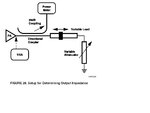Julew
Member level 1

Hello,
I have to measure the impedance of a zigbee transmiter (2.4Hz ISM band). As i read in AN1811 from National Semi (now TI ) the best way to measure that impendance is with a variable load, variable attenuator and a directional coupler.
) the best way to measure that impendance is with a variable load, variable attenuator and a directional coupler.

I havent got too much experience in RF so i dont know how to built the variable load and variable attenuator or where can i buy them. Can i use any variable L/C as variable load? Can i solder them in a perforated pcb with some SMA connector?
I buy componentes in normal distributors like farnell, digikey, amidata, mouser...
Thanks!
Julen
I have to measure the impedance of a zigbee transmiter (2.4Hz ISM band). As i read in AN1811 from National Semi (now TI

I havent got too much experience in RF so i dont know how to built the variable load and variable attenuator or where can i buy them. Can i use any variable L/C as variable load? Can i solder them in a perforated pcb with some SMA connector?
I buy componentes in normal distributors like farnell, digikey, amidata, mouser...
Thanks!
Julen





